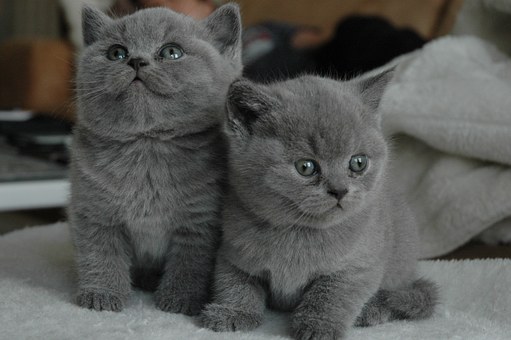Thanks to a request from a reader, your cantankerous cat lady is giving you information in this post about the Russian blue cat breed.

EARLY HISTORY
In early days, the Russian blue cat lived in the wilderness of Russia. Due to their thick double coat, they do well in a cool climate. Long ago, before they became popular and then were recognized as a breed, they were hunted for a time because of their dense fur. It is said that even today wild grey cats still live in Russia’s wilderness.
Some stories tell us that the Russian blue cats of today are descendants of royal felines kept by the Russian tsars. Other sources say that the cat actually originated in Northern Russia’s Archangel Isles.
THE CATS LEARN TO SAIL
In the early 1800s these cats were picked up by sailors to accompany them on their sailing ships. These sailors brought the grey cats to Great Britain and Northern Europe in the 1860s. The sailors came to Europe from Arkhangelsk, one of the most important ports in the Russian Empire.
Being from the Archangel Isles, the animal gained the nickname of the Archangel Cat. Other early names included the Maltese and the foreign blue.
CAT SHOW FAME COMES THEIR WAY
 In 1875, the breed was shown at the world’s first cat show in the Crystal Palace in London. Then, in Britain in 1912, the cat was recognized as a distinct breed. During World War II, the number of these cats dwindled. However, after the war ended, breeders in several countries saved the Russian blues by crossbreeding them with other cats.
In 1875, the breed was shown at the world’s first cat show in the Crystal Palace in London. Then, in Britain in 1912, the cat was recognized as a distinct breed. During World War II, the number of these cats dwindled. However, after the war ended, breeders in several countries saved the Russian blues by crossbreeding them with other cats.
Today, the Russian blue’s appearance in different parts of Europe varies. Scandinavians mated the cat with the Siamese, which produced a longer, more angular look. In Britain, crossbreeding a bluepoint Siamese and a British blue developed a shorter, stockier-built cat.
This feline first arrived in America in the 1900s, but it was much later before people in the United States began breeding the animal in earnest. Russian blues imported from Scandinavia or England were bred with their American cousins, combining features to produce the blue-furred, green-eyed cat that is today’s Russian Blue.
A POSSIBLE CAT FOR YOU IF YOU HAVE ALLERGIES
If you are prone to allergies, the Russian blue might be just the cat for you. Evidence found shows that this cat produces less of the glycoprotein, Fel d 1, which is one of the most common allergens of cats.
This Fel d 1 is the protein in cat saliva and in skin secretions that can start you itching and sneezing. The cat does, however, still produce dander, which will not help your allergies.
These cats shed a little, but since they are shorthaired, their shedding is less extreme than with many other breeds.
If you or a family member suffer from pet allergies, read this story to learn more about how to deal with them. https://myadviceforbaby.com/pet-allergies-in-children-how-best-to-manage-them

CHARACTERISTICS OF THE BREED
To tell if your cat is a Russian blue, look for some common traits, shown below.
They have a short, dense coat. It is a uniform grey color (or blue, as it is called.) A silvery sheen lends to the cat’s blue appearance. A diluted version of the gene causing black hair produces the silvery coat seen on the Russian blue.
Some Russian blue kittens are born with “ghost stripes,” faint tabby marks that disappear as the kitten matures.
Their double-layered coat is very silky. Some Russian Blues also have a soft undercoat of white hair.
The true Russian blue has bright green eyes. Without these characteristics. the cat is probably a domestic shorthair. If paired with a confirmed Russian blue, the cat should have Russian blue kittens. If mated with a shorthair, the kittens’ coats could possibly have a variety of colors.
The double-layered coat is very dense. If you trace patterns on the coat with your fingers, the designs you create will stay in the fur until you smooth the coat over again.
The cat’s body is lean, fine-boned, and muscular. It was once named the “Doberman Pinscher of Cats” at a cat show by a judge,  because of the cat’s long, muscular body, both elegant and athletic. The head is triangle-shaped. It has pointed ears and wide, round eyes.
because of the cat’s long, muscular body, both elegant and athletic. The head is triangle-shaped. It has pointed ears and wide, round eyes.
The Russian blue’s mouth turns up naturally, and because of this mouth shape, tie animal seems to be smiling. This smile has been compared to that of the Mona Lisa.
BEHAVIOR TO EXPECT
Do keep that litter box clean, as these cats are very fussy. If the box is not spotless, they may find another spot that they think is cleaner.
Establish a routine of mealtimes and stick to it. Russian blues love to eat. It is a creature of habit and expects meals to be on time. However, don’t let that opportunist cat convince you that it needs more to eat. Just feed the allotted serving. Check with your vet to get a recommendation as to how much to feed and how often, and then stick to it. Don’t succumb to that insistent “I’m still hungry” cry. If the cat has had the proper portion, it just needs to learn that begging for more is not going to work.
 Your Russian blue loves to play and is especially fond of playing “fetch.” You may need to install locks on cabinet doors as your nosy cat will open them to check the contents. However, once you cat-proof your house, your fur baby will be fine with being alone for the day. This cat is very independent, and handles being alone very well.
Your Russian blue loves to play and is especially fond of playing “fetch.” You may need to install locks on cabinet doors as your nosy cat will open them to check the contents. However, once you cat-proof your house, your fur baby will be fine with being alone for the day. This cat is very independent, and handles being alone very well.
This cat is curious but calm, affectionate but not clingy, and very smart. Though shy at first, once the cat is comfortable with you, it is playful and loving.
The Russian blue tends to bond one-on-one, with one special person. Once you become bonded, your Russian blue will be very sensitive to your emotions. They might even pat your face to cheer you up if you are sad.
If you are sick, the cat might stay close by and send you healing vibes, along with that wonderful purr. If you are watching a movie, the cat loves to snuggle by your side. This feline moves with the grace of a Russian dancer, and might dance through your house whenever the mood strikes, day or night. It also loves high places, where it can sit and watch the activity in the house for hours.
There are always folklore stories about the earth’s creatures. One story about the Russian blue is that if it is kept in a newborn’s bedroom, it will chase away evil spirits.
Though she may ignore guests, she is very loyal to family members. If you are her favorite, she may follow you everywhere, or jump up on your shoulder for a ride.
REFERENCES FOR THIS STORY
I used references for this article, including the following: mentalfloss.com, ASPCA,and “Catster” magazine. If you have more questions regarding this breed, please ask and I will try to find you an answer. Also, comments after you read the story are much appreciated.



This is an interesting article on Russian blue cats. I love cats and had one years ago, but unfortunately my oldest daughter is allergic to them so I had to give up on that dream. I didn’t know there was a “hypoallergenic” cat. It’s about time! Ha!
I love the gray coat and green eyes of this cat breed, and I like that it’s called the Doberman Pinscher of Cats. My only complaint about cats is the darn kitty litter. Too bad they can’t be like dogs and go outside for this purpose. Oh well, I still adore them! Thanks for researching these fun facts on this beautiful breed.
Yes, it is true, we “cat slaves” have to keep that litter box clean. Not the funnest part of having a cat. I cleaned my cat’s box twice a day, just to make sure it stayed acceptable. I did discover one helpful trick. I started using clumping litter. Then, when they pee, you can just scoop out the whole clump that is wet and find someplace outside to pitch it. It is much easier than my old method of dumping the whole box and washing it with warm soapy water. I still did that on occasion with the clumping litter, but didn’t have to do it near as often, and it was much easier to keep the box clean.
What a wonderful post! I didn’t like cats because when a cat passes near me i directly sneeze and cough that’s mean i am allergic to cats. With your post you mentioned that Russian blue kittens are recommended to people with allergy to cats.
That’s good to hear and i need to know where i can find such type of kittens
Thank you
It’s sad to be allergic to these sweet, furry creatures. They are so much fun to share your home with. If you wanted to check into getting a Russian blue, you could check with your vet, to see if he knows where you could get them. There are also sources online for finding them. Hope you get one!
This was a very in depth article that really touched base on every single aspect of the Russian blue cat. I personally found it very interesting and am amazed at their potential! It’s great to see that they’re a bit more allergy friendly and has less shedding which is perfect for someone like me that has plenty of pet allergies. Great read – your post wants to make me get one myself.
I’m glad you enjoyed the post. Funny — it had the same effect on me. Now I want one. Of course, after I wrote the article about the Norwegian Forest cat, I wanted one of them, too. I believe cats are a force for good.
Wow that was an awesome read!
Thank you so much for the effort you put into this article. I really enjoyed reading the history about the Russian Blue Cat and how it made it was form the wild to crossing seas! The independent cat is definitely my kind of cat, but for me I currently either have a very dependant cat or I am the favourite 🙂 because he follows me everywhere (which i actually like now) and is always hungry apparently.
If you had a Russian Blue, how do you think it would handle a new addition to the family?
Thanks again!
My cats were always the same way, and always were trying to convince me they needed more to eat. I used to call them “opportunist cats,” Apparently the Russian blue is also this kind of cat. However, even though he bonds seriously with his number 1 family member, he can handle being alone because of his independent nature. Personally, I’d like one so I could trace designs in its fur…lol…sounds like fun.
If I had a Russian blue and wanted to add a family member, I would try it, for sure. The new cat has to learn to accept the other cat, and he has to learn to fit into another’s territory. It’s best to keep them separated for a time, until they get used to the other’s smell. You might even put something your present cat has been sleeping on with your new friend to make sure they understand that this is a new family member. Let them get together after a few days, while you are there. It might take some time, but most animals adjust to a newcomer eventually, and often they become best friends. Good luck!
I really enjoyed reading about the Russian Blue Cat breed. This breed of cat is truly beautiful. I really had no idea that cats had a double coat, and this breed would be ideal for an allergy sufferer. I have always loved cats, and my family always had a cat as a family pet. I love that this breed is loyal, and loving. I would love to add a cat to my family, I currently own a dog, and am wondering if this breed would get along with dogs?
It’s worth a try. It depends on the two animals. If you keep them separate for a while, so they get used to each other’s smell, and become accustomed to each other, they have a better chance. Then bring them together while you are there to supervise. Cats and dogs do get to be quite good friends at times. I would hope it would work for you.
Such a beautiful breed, I love them! My friend have one and they truly are fussy and love to eat. Didn’t knew all the history behind them, now I know why they are called like that thanks for sharing this information:)
I’m not sure that this cat is good for people with allergies though, because as you said they produce dander so I think the title is a bit misleading.
How lucky you were to be acquainted with one of these cats! My aunt had one. It was a very sweet animal. Yes, you are right; they do still produce dander. Having this cat could still lead to allergy problems, but not as severe. Perhaps if you were a family and one of you was allergic, and the other did all the care-giving, it might work. I know my son is allergic to cats. However, they owned cats for a long time. He could let them on his lap and pet them a little, but that was all.